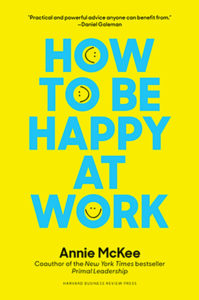When in dire straits, it’s natural to run away from the problem. And there are different ways of running away, of course. The most obvious is to quit your job. A not-so-obvious way is to shut down. We all know these people: they are physically present at work but their minds and hearts are somewhere else.
There are times of course when running away is the right thing to do but it’s better—much better—to run toward something. This requires you to engage in intentional change, a process of planning for the future developed by my good friend Richard Boyatzis. (You can read more about it in Becoming a Resonant Leader) . It’s important to understand that when you’ve heard a wake-up call, you need to engage optimism and commit to a positive outlook about the future. Easier said than done, I know. But it’s essential. Otherwise, you may make rash—even stupid—decisions that you may regret.
For intentional change to work, you also need to tap into confidence and self-efficacy. You may be beaten down. Your resilience and strength may be drained. But, as you see that glimmer of hope about the future, your natural belief in yourself will begin to grow. Trust yourself: If you’ve heard the call, and if you commit to moving toward a dream rather than running away, you are ready to craft a personal vision and a plan to get there.
Intentional Change includes five interrelated steps:
1. Crafting Your Personal Vision
Begin by determining which aspects of your life are important to you—even those you may not spend a lot of time on now. Most people include things like family, love, health, spirituality, and work. Other people include friendships, making a difference, learning and growth, or living a comfortable life. Certainly, you’ll want to include work, too.
Next, think about how you’d like all of those aspects of your life to be in the future. Where do you want to live and with whom? What will you be doing? What kind of job or profession will you have? What kind of lifestyle will you have? What do you want your daily life to be like?
2. Seeing the Truth of Today—My Real Self
The next step is to take stock. Where are you now? What strengths do you have that will help you bridge the gap between today and that future vision? What resources do you see in your immediate environment or on the horizon? And, of course, what’s missing? Do you need new skills or more education? Do you need a different social environment or a new set of professional colleagues? Do you need to attend to your health and well-being?
3. Creating a Learning Plan
The next step is to create a learning plan. A learning plan is more than goals and milestones—it is a plan for what you need to learn or change in order to reach your dream? Most learning plans include no more than five or six learning goals, each of which will take a year or more to attain. For example, maybe you see yourself reaching the executive suite in your company as part of your life vision. At present, you’re a middle manager who’s come up through product development. You know you need to broaden your experience, so a learning goal might be to: “Seek and attain a job in marketing and sales.”
4. Finding People Who Want to Help
Asking for help is not always easy. But when it comes to change of the magnitude we’re talking about, you can’t do this alone. Finding the right people can be tough. It’s not always safe to ask for help from people at work. Just because you are on a path toward happiness and health doesn’t mean others in your workplace are and they may be resentful. And it if the culture is toxic, you have to watch out for how people could use your request against you.
5. Experimenting and Practice
The next step is to make progress on your plan and learn along the way. This means you will need to take some risks, think differently, and behave differently, too. There are two things to keep in mind as you begin to try on a new attitude and new ways of approaching your work: make time for experimenting and be compassionate with yourself.
- Make time: If you try to add all of the actions in your learning plan to your already over-busy life, you will fail. You can’t do this unless you change how you spend your time. Here are some practical tips for changing how you spend your time:
- Stop talking with people at work about how bad things are
- Don’t go to meetings you don’t need to attend
- Work at home at least once a week if you can; cut down your commute by going on non-peak hours; even better, if it’s a short distance, walk, or bike to work.
- Learn to use technology better
- Don’t look at email or texts every hour (much less every ten minutes)
- Be Compassionate with Yourself: Very few of us can enter into a change process like this without tripping up and making mistakes. Be kind to yourself. Catalog wins and successes as you go. And, when you find yourself having a hard time learning or reaching a goal, focus on the learning, not the problems or stumbling blocks. And be brave.
Excerpted from How to Be Happy at Work by Annie McKee, Harvard Business Review Press, 2017

You Deserve to Be Happy at Work
Based on extensive research and decades of experience with leaders, How to Be Happy at Work deepens our understanding of what it means to be truly fulfilled and effective at work and provides clear, practical advice and instruction on how to get there―no matter what job you have.